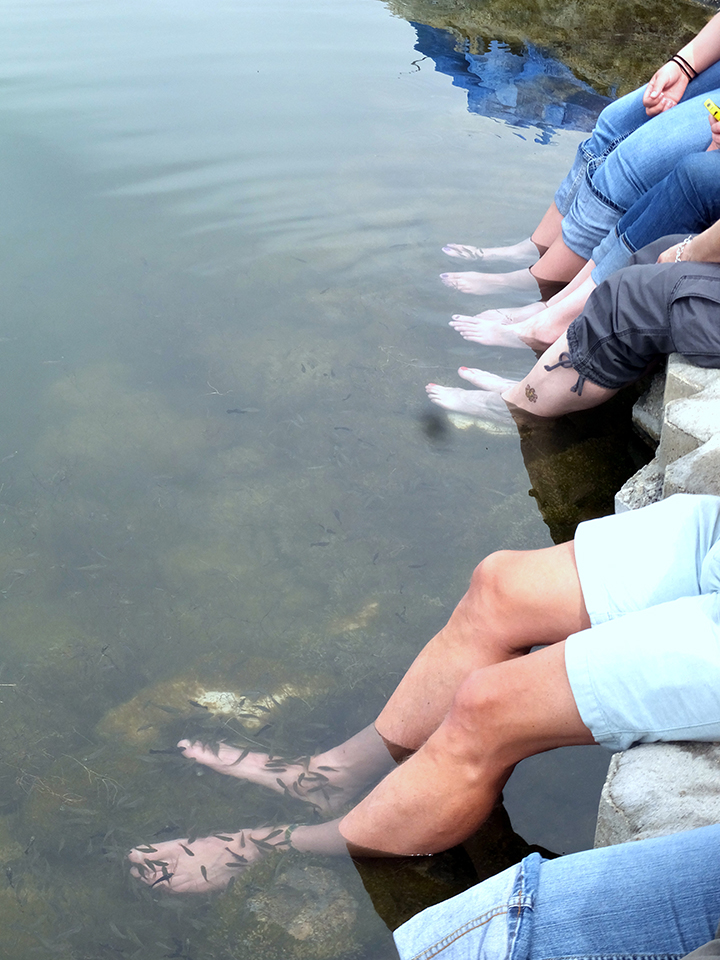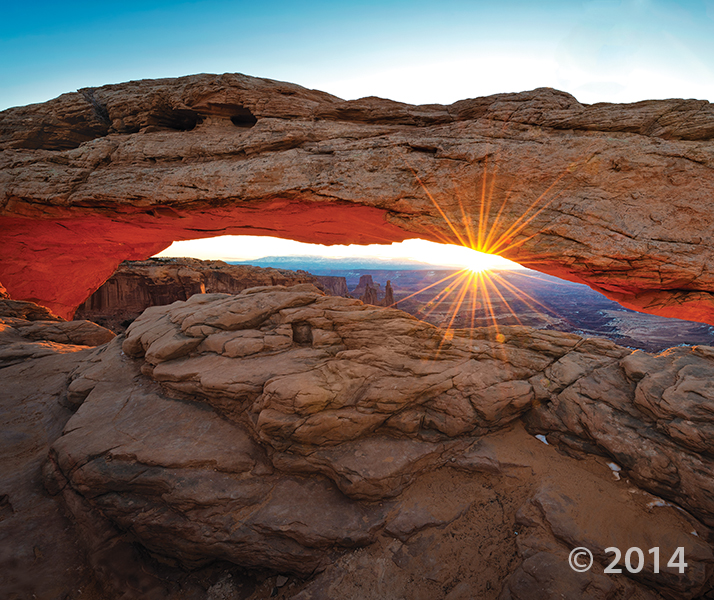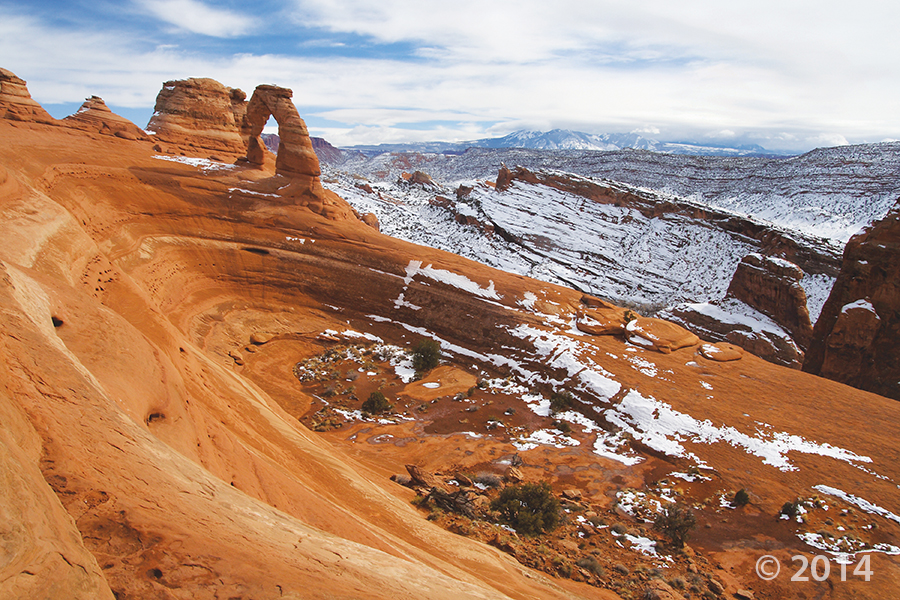Tag Archive for: Utah Geological Survey
We woke up on the right side of the bedrock today!
Canyonlands National Park, San Juan County, Utah
Photographer: Gregg Beukelman; © 2014
Mesa Arch, in the Island in the Sky District of Canyonlands National Park, formed as surface water pooled and eventually eroded through bedrock at the mesa’s edge. As the sun rises, its rays reflect off the 800-foot-high cliff of Jurassic-age sedimentary rock below the arch, bathing the bottom of the arch in an orange glow.
On June 4th the Utah Geological Survey embarked on the 2015 Administrative Professionals Geologic Field Trip. This year our group started off early at Bonneville Seabase in Tooele Valley, the Intermountain West’s spot to SCUBA and snorkel year-round amongst tropical marine fish. Our excellent tour guide, Ron, postponed the daily morning fish feeding until we arrived (thanks Ron!). Seabase is three bays fed by natural warm springs with a chemistry that approximates seawater. Water temperatures are in the 70s and 80s and water depths up to 62 feet. Although no one in our group went diving or snorkeling, we delighted in watching the colorful fish and putting our feet in the water and having mollies nibble our toes.
Next we headed south to the Stockton Bar, a world class geomorphic feature first interpreted by legendary geologist Grove Karl “GK” Gilbert in USGS Monograph 1, 1890. Geologist Mark Milligan explained that this feature signifies one of the largest and best-preserved shoreline remnants of Ice Age Lake Bonneville. Waves and currents transported sand and gravel to create a bar connecting South Mountain to the Oquirrh Mountains about 18,000 years ago when Lake Bonneville reached its highest level.
Continuing south our final stop was the former mining town of Ophir, nestled in a beautifully craggy and forested canyon. We were greeted by the Ophir mayor, Walt Shubert, and his wife Betty. Reynold “Ren” Willie, decorated retired geoscience teacher, Utah historian, Ophir native, and son of the superintendent of the Lark, Ophir, Gold Hill, and Hidden Treasure Mines, gave us a marvelous and memorable tour of the town. Ophir has preserved many of the old buildings and mining paraphernalia from the time it was a boomtown. From the 1860s to 1900, Ophir produced millions of dollars in silver, lead, and zinc; at one time reaching a population of 6,000 people. Ophir was a perfect place to conclude our informative day in the field.

Mining relicts in scenic Ophir Canyon.

Mark explains the origin and significance of the Stockton Bar (flat feature in background).

Observing the tropical marine fish at Bonneville Seabase.

Soaking our feet and getting a “Mollie Pedicure” at Bonneville Seabase.

The UGS poses in front of ore carts at historic Ophir.
Arches National Park, Grand County, Utah
Photographer: Sonja Heuscher; © 2014
The view through North Window arch in The Windows Section of Arches National Park reveals snow-covered sandstone spires and fins of the Jurassic-age Entrada Sandstone. The spires and fins result from weathering and erosion along parallel fractures, or joints, in the rock.
By: Rebekah E. Wood and Thomas C. Chidsey, Jr.
This CD contains an easily viewable 1:700,000-scale map in PDF format of Utah’s oil, gas, and CO₂ fields (past and present); oil gas and CO₂ pipelines with operators; field designations; names and ages of the reservoir rocks; oil refineries and natural gas processing plants; park boundaries and other geographical attributes; and some surficial geologic features. This map is to be used for a general overview and reference for hydrocarbon resources, production, transportation, and processing in Utah. Also included are geographic information system (GIS) files in ESRI file geodatabase and shapefile formats. The latest version of Adobe Reader is required to view the PDF file.
See our news release for this publication HERE
By: Steven Schamel
The Green River Formation in the Uinta Basin has may characteristics typical of an ideal shale oil resource play. It is a world-class oil-prone source rock. In nearly all parts of the basin there are many thousands of net feet of Type-l and Type-ll kerogen-rich calcareous mudstones, many intervals of which have average total organic carbon (TOC) of 5-10% or greater. In the north-central and western parts of the basin a substantial part of the formation is in the oil-generative window. Furthermore, organic maturation simulations done in this study using PRA BasinView-3D™ indicates early entry into the oil-generative window. In the northwest parts of the basin the lower Green River Formation was generating oil even before the end of the Eocene and slowing of sediment accumulation in the basin. The Green River Formation is unquestionably a superb petroleum system responsible for very large cumulative production of oil and associated natural gas, and an even larger potential oil sand resource. This DVD contains a 65-page report.
By: S. Robert Bereskin, John D. McLennan, Thomas C. Chidsey, Jr., and Peter J. Nielsen
The Mississippian Chainman Shale represents a potential target for untapped oil and gas resources in western Utah and eastern Nevada. This study focuses on the lithologic, facies, petrographic, petrophysical, and geochemical characteristics of a 500-meter-thick Chainman stratigraphic section exposed in the central Confusion Range of western Millard County, Utah. A hypothetical resources assessment, which can be used for the Chainman regionally, was conducted based on the surface samples’ attributes from the study area. Hypothetical undiscovered hydrocarbons on 80-acre spacing are estimated at 270,000 barrels of oil and 1.5 billion cubic feet of gas per well.
See our news release for this publication HERE
Utah is an important source of crude oil and natural gas, and is currently ranked 11th in United States production. Driven by a decadal long increase in Utah’s oil and gas production, the Utah Geological Survey (UGS) recently released an updated Oil and Gas Fields Map of Utah that shows where most drilling activity has occurred, namely within the Uinta and Paradox Basins in eastern and southeastern Utah, respectively.
This updated map displays Utah’s oil, gas, and carbon dioxide reservoirs; major pipelines; and gas storage fields. In addition to easily identifying areas of current production and potential exploration, the map also shows areas that will not be developed such as national parks and monuments, recreation areas, historic sites, and rock units not expected to contain oil and gas resources. It is beneficial for geologists, engineers, landowners and other stakeholders, as well as state, federal, and county government officials.
The UGS and State of Utah School and Institutional Trust Lands Administration funded this map with the intent to provide an up-to-date quick reference for Utah’s oil and gas resources, production, transportation, and processing. The map, UGS Circular 119, is available for purchase on CD with GIS files, or as a print-on-demand map at the Utah Department of Natural Resources Map and Bookstore, 1-888-UTAHMAP, http://www.mapstore.utah.gov/.
For more information about this map, please contact Rebekah Wood at rwood@utah.gov or 801-537-3378.
Media Contact
Nathan Schwebach
801-538-7303
nathanschwebach@utah.gov




















